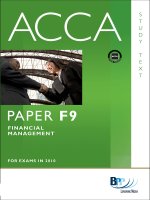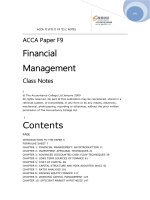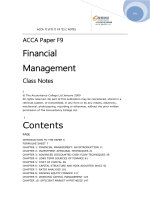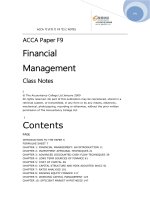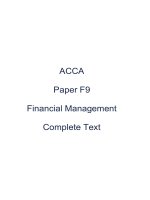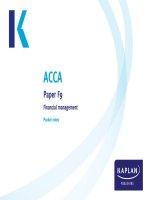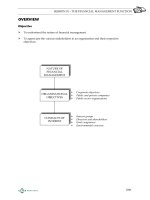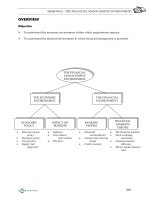ACCA paper f9 financial management study materials F9FM session04 d08
Bạn đang xem bản rút gọn của tài liệu. Xem và tải ngay bản đầy đủ của tài liệu tại đây (456.02 KB, 22 trang )
SESSION 04 – DISCOUNTED CASH FLOW TECHNIQUES
OVERVIEW
Objective
To apply the time value of money to investment decisions.
INTEREST
SIMPLE
COMPOUND
DISCOUNTING
Single sum
Annuities
Effective Annual Interest Rates
(EAIR)
“Compounding in
reverse”
Points to note
DISCOUNTED
CASH FLOW (DCF)
TECHNIQUES
Procedure
Meaning
Cash budget pro forma
Tabular layout
Annuities
Perpetuities
Definition and decision
rule
Perpetuities
Annuities
Uneven cash flows
Unconventional cash
flows
Time value of money
DCF techniques
NET PRESENT
VALUE (NPV)
INTERNAL RATE
OF RETURN (IRR)
NPV vs. IRR
Comparison
0401
SESSION 04 – DISCOUNTED CASH FLOW TECHNIQUES
1
SIMPLE INTEREST
Interest accrues only on the initial amount invested.
Illustration 1
If $100 is invested at 10% per annum (pa) simple interest:
Year
Amount on deposit
(year beginning)
$100
$110
$120
1
2
3
Interest
0.1 × 100 = 10
0.1 × 100 = 10
0.1 × 100 = 10
Amount on deposit
(year end)
$110
$120
$130
A single principal sum, P invested for n years at an annual rate of interest, r (as a
decimal) will amount to a future value FV.
Where FV = P (1 + nr)
2
COMPOUND INTEREST
Interest is reinvested alongside the principal.
2.1
Single sum
Illustration 2
If Zarosa placed $100 in the bank today (t0) earning 10% interest per annum,
what would this sum amount to in three years time?
Solution
In 1 year’s time, $100 would have increased by 10% to $110
In 2 years’ time, $110 would have grown by 10% to $121
In 3 years’ time, $121 would have grown by 10% to $133.10
Or
FV = P (1 + r) n
where
P
=
initial principal
r
=
annual rate of interest (as a decimal)
n
=
number of years for which the principal is invested
0402
SESSION 04 – DISCOUNTED CASH FLOW TECHNIQUES
Example 1
$500 is invested in a fund on 1.1.X1. Calculate the amount on deposit by
31.12.X4 if the interest rate is
(a) 7% per annum simple
(b) 7% per annum compound.
Solution
The $500 is invested for a total of 4 years
(a)
Simple interest
FV = P (1 + nr)
FV =
(b)
Compound interest
FV = P (1 + r)n
FV =
Example 2
$1,000 is invested in a fund earning 5% per annum on 1.1.X0. $500 is added to
this fund on 1.1.X1 and a further $700 is added on 1.1.X2. How much will be
on deposit by 31.12.X2?
Solution
Date
Amount ×
invested
$
1.1.X0
1.1.X1
1.1.X2
1,000
500
700
Compound
interest factor
Amount on deposit
=
Compounded
cashflow
$
_________
=
_________
0403
SESSION 04 – DISCOUNTED CASH FLOW TECHNIQUES
2.2
Annuities
Many saving schemes involve the same amount being invested annually.
There are two formulae for the future value of an annuity. Which to use depends on
whether the investment is made at the end of each year or at the start of each year.
(i) first sum paid/received at the end of each year
(ii) first sum paid/received at the beginning of each year
(1 + r )n − 1
(i) FV = a
r
where
a
r
n
(1 + r )n + 1 − 1
− 1
(ii) FV = a
r
= annuity (i.e. annual sum)
= interest rate (interest payable annually in arrears)
= number of years annuity is paid/invested
Commentary
These formula will not be provided in the examination
Illustration 3
Andrew invests $3,000 at the start of each year in a high interest account
offering 7% pa. How much will he have to spend after a fixed 5 year term?
Solution
(1.07 )6 − 1
− 1 = $3,000 × 6.153 = $18,460
FV = $3,000 ×
0.07
2.3
Effective Annual Interest Rates (EAIR)
Where interest is charged on a non-annual basis it is useful to know the effective annual
rate.
Foe example interest on bank overdrafts (and credit cards) is often charged on a
monthly basis. To compare the cost of finance to other sources it is necessary to know
the EAIR.
Formula
1 + R = (1 + r) n
R = annual rate
r = rate per period (month/quarter)
n = number of periods in year
0404
SESSION 04 – DISCOUNTED CASH FLOW TECHNIQUES
Illustration 4
Borrow $100 at a cost of 2% per month. How much (principal + interest) will
be owed after a year?
Using FV
= P (1 + r)n
⇒
= £100 × (1.02)12
= £100 × 1.2682 * = £126.82
EAIR is 26.82%
3
DISCOUNTING
3.1
“Compounding in reverse”
Discounting calculates the sum which must be invested now (at a fixed interest rate) in
order to receive a given sum in the future.
Illustration 5
If Zarosa needed to receive $251.94 in three years time (t3), what sum would
she have to invest today (t0) at an interest rate of 8% per annum?
Solution
The formula for compounding is:
FV = P (1 + r) n
Rearranging this:
P = FV ×
1
(1 + r ) n
or alternatively PV = CF ×
where
PV
r
n
1
(1 + r ) n
= the present value of a future cash flow (CF)
= annual rate of interest/discount rate.
= number of years before the cash flow arises
In this case PV = $251.94 ×
1
= $200
(1.08) 3
The present value of $251.94 receivable in three years time is $200.
0405
SESSION 04 – DISCOUNTED CASH FLOW TECHNIQUES
3.2
Points to note
1
is known as the “simple discount factor” and gives the present value of $1
(1 + r) n
receivable in n years at a discount rate, r.
A present value table is provided in the exam
The formula for simple discount factors is provided at the top of the present value
table.
For a cash flow arising now (at t0) the discount factor will always be 1.
t1 is defined as a point in time exactly one year after t0.
Always assume that cash flows arise at the end of the year to which they relate (unless
told otherwise).
Example 3
Find the present value of
(a) 250 received or paid in 5 years time, r = 6% pa
(b) 30,000 received or paid in 15 years time, r = 9% pa.
Solution
(a) From the tables: r = 6%, n = 5, discount factor =
Present value =
(b) From the tables: r = 9%, n = 15, discount factor =
Present value =
0406
SESSION 04 – DISCOUNTED CASH FLOW TECHNIQUES
4
DISCOUNTED CASH FLOW (DCF) TECHNIQUES
4.1
Time value of money
Investors prefer to receive $1 today rather than $1 in one year.
This concept is referred to as the “time value of money”
There are several possible causes:
Liquidity preference – if money is received today it can either be spent or
reinvested to earn more in future. Hence investors have a preference for having
cash/liquidity today.
Risk – cash received today is safe, future cash receipts may be uncertain.
Inflation – cash today can be spent at today’s prices but the value of future cash
flows may be eroded by inflation
DCF techniques take account of the time value of money by restating each
future cash flow in terms of its equivalent value today.
4.2
DCF techniques
DCF techniques can be used to evaluate business projects i.e. for investment appraisal.
Two methods are available:
NET PRESENT
VALUE
INTERNAL RATE
OF RETURN
0407
SESSION 04 – DISCOUNTED CASH FLOW TECHNIQUES
5
NET PRESENT VALUE (NPV)
5.1
Procedure
Forecast the relevant cash flows from the project
Estimate the required return of investors i.e. the discount rate. The required return of
investors represents the company’s cost of finance, also referred to as its cost of capital.
Discount each cash flow (receipt or payment) to its present value (PV).
Sum present values to give the NPV of the project.
If NPV is positive then accept the project as it provides a higher return than required by
investors.
5.2
Meaning
NPV shows the theoretical change in the $ value of the company due to the project.
It therefore shows the change in shareholders’ wealth due to the project.
The assumed key objective of financial management is to maximise shareholder wealth.
Therefore NPV must be considered the key technique in business decision making.
5.3
Cash budget pro forma
Time
0
$000
1
$000
2
$000
3
$000
Capital expenditure
Cash from sales
Materials
Labour
Overheads
Advertising
Grant
(X)
–
(X)
–
–
(X)
–
___
–
X
(X)
(X)
(X)
–
X
___
–
X
(X)
(X)
(X)
(X)
–
___
X
X
–
(X)
(X)
–
–
___
Net cash flow
(X)
___
X
___
X
___
X
___
1
1
1+ r
1
(1 + r ) 2
1
(1 + r )3
(X)
X
X
X
r% discount factor
Present value
NPV = X
0408
SESSION 04 – DISCOUNTED CASH FLOW TECHNIQUES
5.4
Tabular layout
Time
0
1–10
0–9
1–10
0
2
1
10
Cash flow
$000
Discount
factor
@ r%
Present
value
$000
(X)
X
(X)
(X)
(X)
(X)
X
X
1
x
x
x
x
x
x
x
(X)
X
(X)
(X)
(X)
(X)
X
X
___
CAPEX
Cash from sales
Materials
Labour and overheads
Advertising
Advertising
Grant
Scrap value
Net present value
X
___
Example 4
Elgar has $10,000 to invest for a five-year period. He could deposit it in a bank
earning 8% pa compound interest.
He has been offered an alternative: investment in a low-risk project that is
expected to produce net cash inflows of $3,000 for each of the first three years,
$5,000 in the fourth year and $1,000 in the fifth.
Required:
Calculate the net present value of the project.
Solution
Time
Description
Cash flow
$
0
Investment
(10,000)
1
Net inflow
3,000
2
Net inflow
3,000
3
Net inflow
3,000
4
Net inflow
5,000
5
Net inflow
1,000
8% DF
PV
$
_____
NPV =
_____
0409
SESSION 04 – DISCOUNTED CASH FLOW TECHNIQUES
5.5
Annuities
An annuity is a stream of identical cash flows arising each year for a finite period of
time.
The present value of an annuity is given as
CF ×
1
1
1 −
r (1 + r) n
where CF is the cash flow received each year commencing at t1.
1
1
is known as the “annuity factor” or “cumulative discount factor”. It is
1 −
r (1 + r) n
simply the sum of a geometric progression.
The formula is given in the exam as
1 - (1 + r) −n
r
Annuity factor tables are also provided in the exam
Remember that the formula and tables are based on the assumption that the cash flow
starts after one year.
Illustration 6
Calculate the present value of $1,000 receivable each year for 3 years if interest
rates are 10%.
Time
Description
t1–3
Annuity
Cash flow
$
1,000
10% Annuity factor
1
1
1−
= 2.486
0.1
1.1 3
Note: An annuity received for the next three years is written as t1–3.
Example 5
Calculate the present value of $2,000 receivable for each of 10 years
commencing three years from now. Assume interest at 7%.
0410
PV
$
2,486
SESSION 04 – DISCOUNTED CASH FLOW TECHNIQUES
Solution
5.6
Perpetuities
A perpetuity is a stream of identical cash flows arising each year to infinity.
As n → ∞
(1 + r)n → ∞
1
→0
(1 + r) n
1
1
1 −
r
(1 + r ) n
1
→
r
1
is known as the “perpetuity factor”.
r
The present value of a perpetuity is given as CF ×
1
r
where CF is the cash flow received each year.
The formula is based on the assumption that the cash flow starts after one year.
Illustration 7
Calculate the present value of $1,000 receivable each year in perpetuity if
interest rates are 10%.
Solution
Time
Description
t1–∞
Perpetuity
Cash flow
$
1,000
10% Annuity factor
1
= 10
01
.
PV
$
10,000
0411
SESSION 04 – DISCOUNTED CASH FLOW TECHNIQUES
Example 6
Calculate the present value of $2,000 receivable in perpetuity commencing in
10 years time. Assume interest at 7%.
Solution
6
INTERNAL RATE OF RETURN (IRR)
6.1
Definition and decision rule
IRR is the discount rate where NPV = 0
IRR represents the average annual % return from a project.
It therefore shows the highest finance cost that can be accepted for the project.
If IRR > cost of capital, accept project.
If IRR < cost of capital, reject project.
6.2
Perpetuities
If a project has equal annual cash flows receivable in perpetuity then
IRR =
Annual cash inflows
× 100%
Initial investment
Illustration 8
An investment of $1,000 gives income of $140 per annum indefinitely, the
return on the investment is given by
IRR = 140/1000 × 100% = 14%
0412
SESSION 04 – DISCOUNTED CASH FLOW TECHNIQUES
Example 7
An investment of $15,000 now will provide $2,400 each year to perpetuity.
Required:
Calculate the return inherent in the investment.
Solution
6.3
Annuities
To give an NPV of zero, the present value of the cash inflows must equal the initial cash
outflow.
i.e. annual ash inflow × Annuity factor = Cash outflow
Annuity factor =
Cash outflow
Cash inflow
Once the annuity factor is known the discount rate can be established from the
appropriate table.
Illustration 9
An investment of $6,340 will yield an income of $2,000 for four years.
Calculate the internal rate of return of the investment.
Solution
Year
0
1-4
Description
Initial investment
Annuity
NPV
AF1-4 years =
CF
(6,340)
2,000
DF
1
AF1-4 years
PV
(6,340)
6,340
_____
Nil
_____
6 ,340
= 3.17
2 ,000
From the annuity table, the rate with a four year annuity factor closest to 3.17 is 10% and this
is therefore the approximate IRR for this investment.
0413
SESSION 04 – DISCOUNTED CASH FLOW TECHNIQUES
Example 8
An immediate investment of $10,000 will give an annuity of $1,000 for the next
15 years.
Required:
Calculate the internal rate of return of the investment.
Solution
Time
0
1-15
Description
Investment
Annuity
Cash flow
$
Discount factor
(10,000)
1,000
PV
$
______
______
6.4
Uneven cash flows
Method
Calculate the NPV of the project at a chosen discount rate.
If NPV is positive, recalculate NPV at a higher discount rate (i.e. to get closer to IRR).
If NPV is negative, recalculate at a lower discount rate.
The IRR can be estimated using the formula:
IRR ~ A +
Where
A
B
NA
NB
NA
(B − A)
NA − NB
=
=
=
=
Lower discount rate
Higher discount rate
NPV at rate A
NPV at rate B
This method is known as “linear interpolation”.
0414
SESSION 04 – DISCOUNTED CASH FLOW TECHNIQUES
Illustration 10
The NPVs of a project with uneven cash flows are as follows.
Discount rate
NPV
£
10%
20%
64,237
(5,213)
Estimate the IRR of the investment.
Solution
IRR ~ A +
NA
(B – A)
NA − NB
IRR ~ 10% +
64 ,237
(20 – 10)%
64 ,237 − ( −5,213)
IRR ~ 19%
Graphically
NPV
IRR using formula
(interpolated)
NA
A
NB
Actual IRR
B
Discount rate
Actual NPV as
discount rate varies
0415
SESSION 04 – DISCOUNTED CASH FLOW TECHNIQUES
Example 9
An investment opportunity with uneven cash flows has the following net
present values
$
At 10%
At 15%
Required:
Estimate the IRR of the investment.
Solution
Formula
IRR ~ A +
NA
(B – A)
NA − NB
IRR ~
Graphically
0416
71,530
4,370
SESSION 04 – DISCOUNTED CASH FLOW TECHNIQUES
6.5
Unconventional cash flows
If there are cash outflows, followed by inflows are then more outflows (e.g. suppose at the
end of the project a site had to be decontaminated), the situation of “multiple yields”
may arise – i.e. more than one IRR.
NPV
Actual NPV as
discount rate varies
IRR2
IRR1
Discount rate
Actual IRR
The project appears to have two different IRR’s – in this case IRR is not a reliable
method of decision making.
However NPV is reliable, even for unconventional projects.
7
NPV vs. IRR
7.1
Comparison
NPV
IRR
An absolute measure ($)
A relative measure (%)
If NPV ≥ 0 ,accept
If IRR ≥ target %, accept
If NPV ≤ 0, reject
If IRR ≤ target %, reject
Shows $ change in value of
company/wealth of shareholders
Does not show absolute change in
wealth
A unique solution i.e. a project has only
one NPV
May be a multiple solution
Always reliable for decision making
Not always reliable
0417
SESSION 04 – DISCOUNTED CASH FLOW TECHNIQUES
Key points
Discounted cash flow techniques are arguably the most important
methods used in financial management.
DCF techniques have two major advantages (i) they focus on cash flow,
which is more relevant than the accounting concept of profit (ii) they take
into account the time value of money.
NPV must be considered a superior decision-making technique to IRR as it
is an absolute measure which tells management the change in
shareholders’ wealth expected from a project.
FOCUS
You should now be able to:
explain the difference between simple and compound interest rate and
calculate future values;
calculate future values including the application of annuity formulae;
calculate effective interest rates;
explain what is meant by discounting and calculate present values;
apply discounting principles to calculate the net present value of an investment project
and interpret the results;
calculate present values including the application of annuity and perpetuity formulae;
explain what is meant by, and estimate the internal rate of return, using a graphical and
interpolation approach, and interpret the results;
identify and discuss the situation where there is conflict between these two methods of
investment appraisal;
compare NPV and IRR as decision making tools.
0418
SESSION 04 – DISCOUNTED CASH FLOW TECHNIQUES
EXAMPLE SOLUTION
Solution 1 — 7% simple and compound interest
The $500 is invested for a total of 4 years
(a)
Simple interest
FV = P (1 + nr)
FV = 500 (1 + 4 × 0.07) = 500 × 1.28 = $640
(b)
Compound interest
FV = P (1 + r)n
FV = 500 (1 + 0.07)4 = 500 × 1.3108 = $655.40
Solution 2 — 5% compound interest
Date
1.1.X0
1.1.X1
1.1.X2
Amount
invested
$
×
1,000
500
700
Compound
interest factor
=
(1 + 0.05)3
(1 + 0.05)2
(1 + 0.05)1
Amount on deposit
Compounded
cashflow
$
1,157.63
551.25
735.00
_________
=
2,443.88
_________
Solution 3 — Present value
(a) From the tables: r = 6%, n = 5, discount factor = 0.747
Present value = 250 × 0.747 = $186.75
(b) From the tables: r = 9%, n = 15, discount factor = 0.275
Present value = 30,000 × 0.275 = $8,250
0419
SESSION 04 – DISCOUNTED CASH FLOW TECHNIQUES
Solution 4 — Net present value
Time
Description
Cash flow
$
8% DF
PV
$
0
Investment
(10,000)
1
(10,000)
1
Net inflow
3,000
1
(1.08)
2,778
2
Net inflow
3,000
1
(1.08) 2
2,572
3
Net inflow
3,000
1
(1.08) 3
2,381
4
Net inflow
5,000
1
(1.08) 4
3,675
5
Net inflow
1,000
1
(1.08) 5
681
NPV =
_____
2,087
_____
Solution 5 — Annuity
Time
Description
t3-12
Annuity
Cash flow
$
7% Annuity factor
PV
$
2,000
6.135 (W)
12,270
WORKING
Cdf3-12 @ 7%
=
CDF1-12 @ 7% – CDF1-2 @ 7%
=
7.943 – 1.808 (per tables)
=
6.135
Solution 6 — Perpetuity
0420
Time
Description
Cash flow
$
7% Annuity factor
PV
$
t10-∞
Perpetuity
2,000
7.771 (W)
15,542
SESSION 04 – DISCOUNTED CASH FLOW TECHNIQUES
WORKING
=
Cdf10-∞ @ 7%
=
CDF1-∞ @ 7% - CDF1-9 @ 7%
1
– 6.515 (per tables)
0.07
14.286 – 6.515
=
7.771
=
Solution 7 — IRR (perpetuity)
IRR =
2,400
× 100 = 16%
15,000
Solution 8 — IRR (annuity)
Time
Description
0
1-15
Investment
Annuity
Cash flow
$
(10,000)
1,000
Discount factor
PV
$
1
Cdf1-15 = 10 (βal)
(10,000)
10,000
______
Nil
______
From the annuity table the rate with a 15 year annuity factor of 10 lies between 5% and 6%.
Thus if $10,000 could be otherwise invested for a return of 6% or more, this annuity is not
worthwhile.
Solution 9 — IRR (uneven cash flows)
Formula
Commentary
The formula always works but take care with + and – signs.
IRR ~ A +
NA
(B – A)
NA − NB
71,530
IRR ~ 10 +
(15 – 10)
71,530 − 4 ,370
IRR ~ 10 + 5.325
say 15.4% (rounded up)
0421
SESSION 04 – DISCOUNTED CASH FLOW TECHNIQUES
Graphically
NPV
£
Actual
NPV
71,530
Actual
IRR
4,370
10
15
IRR using
formula
(extrapolated)
0422
Discount rate
(%)

